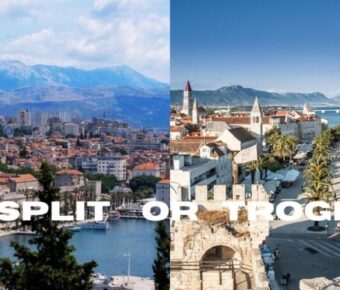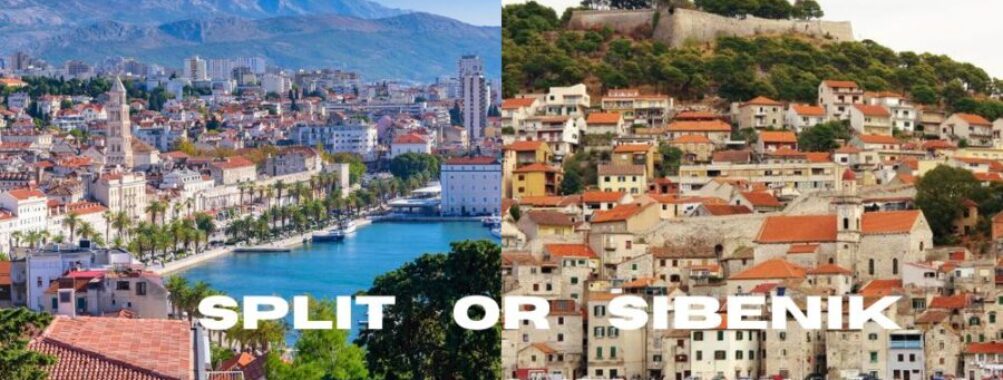
Split vs Sibenik: Which Coastal Croatian City Offers the Better Hidden Gems in 2025
Split and Sibenik stand as two charming Croatian coastal cities, each offering unique experiences for travelers. While Split buzzes with energy as Croatia’s second-largest city, Sibenik maintains a quieter, more authentic atmosphere that many visitors find appealing.
Most travelers prefer Split due to its wider range of activities, better transportation connections, and easy access to nearby islands. The city serves as a major transport hub with frequent ferries, buses, and flights, making it perfect for island hopping or exploring other parts of Croatia.
Sibenik shines as a hidden gem with fewer tourists and more local flavor. Its stunning UNESCO-listed Cathedral of St. James and nearby Krka National Park draw visitors seeking a more laid-back Croatian experience. The city’s smaller size makes it easy to explore on foot, with winding medieval streets leading to unexpected discoveries.
Contents
- Geographic Overview
- Historical Significance
- Historical Timeline of Split
- Historical Timeline of Šibenik
- Cultural and Modern Life
- Cultural Festivities in Split
- Cultural Festivities in Sibenik
- Tourism and Attractions
- Top Attractions in Split
- Top Attractions in Sibenik
- Economic Comparison
- Analysis on Hajduk Split
- Comparative Analysis
- Frequently Asked Questions
- What activities can travelers enjoy when visiting Sibenik?
- How does the historical significance of Split compare to that of Sibenik?
- Which destination between Split and Sibenik offers a more authentic Croatian experience?
- What are the key differences in the cultural attractions of Sibenik and Split?
- Can visitors discover unique culinary experiences in Sibenik, and how does it compare to Split?
- When choosing between a visit to Sibenik or Split, what advantages does each location offer?
- More Travel Guides
Geographic Overview
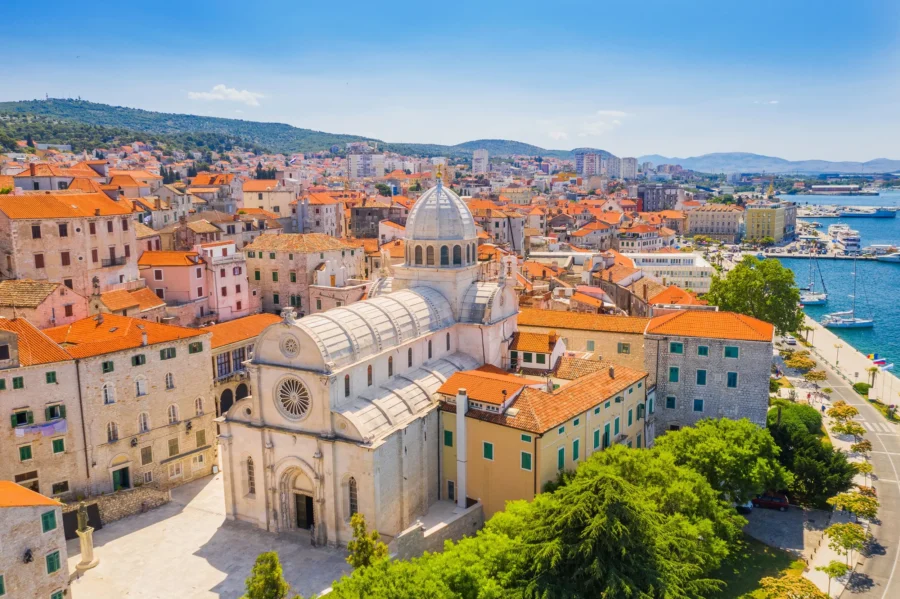
Split and Sibenik sit along Croatia’s stunning Dalmatian Coast, each offering its own unique setting on the Adriatic Sea. Split, the larger of the two cities, spreads across a peninsula with the dramatic backdrop of Mosor Mountain.
Sibenik nestles in a protected natural harbor where the Krka River meets the sea. The city rises up the hillside in tiers, with its stone buildings and fortresses creating a striking amphitheater-like appearance.
Both cities enjoy a typical Mediterranean climate with warm summers and mild winters. The waters around both locations are dotted with islands and hidden coves perfect for swimming and boating.
Split’s most notable geographic feature is its position on a peninsula, with the famous Marjan Hill providing green space and panoramic views. The city center wraps around its ancient harbor, making it a natural transportation hub.
Sibenik’s location at the river mouth gives it a different character. The Krka River’s influence creates a unique ecosystem where fresh and salt water meet. The city is sheltered by a network of small islands that protect its harbor.
The limestone hills behind both cities create dramatic backdrops and influence the local architecture. These rocky formations have played a key role in shaping the cities’ development and defensive positions throughout history.
Historical Significance
Split and Šibenik stand as remarkable examples of Dalmatian coastal cities with rich histories spanning thousands of years. Both cities showcase impressive architectural heritage and cultural importance through various ruling powers.
Historical Timeline of Split
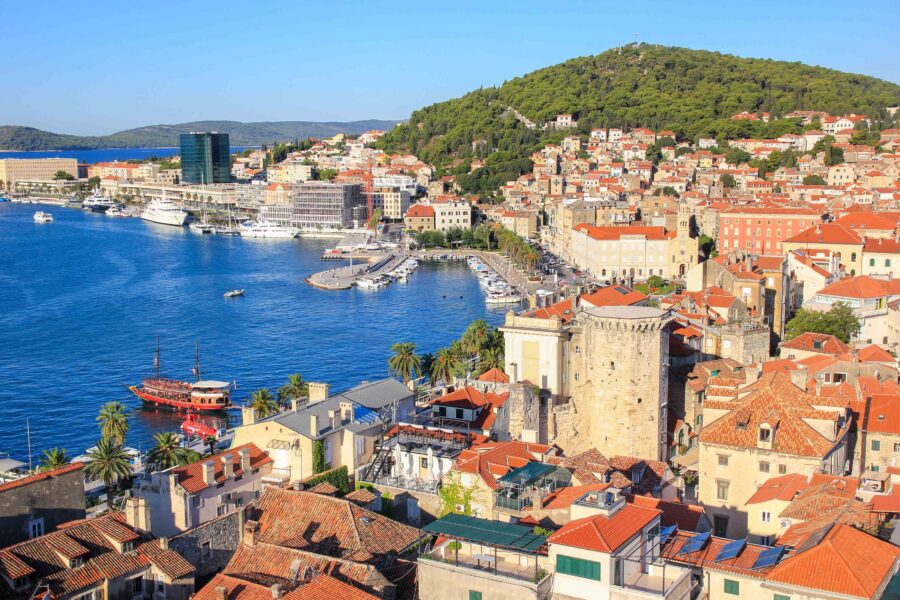
Split traces its roots to the Roman era when Emperor Diocletian built his palace in 305 AD. The palace still forms the heart of Split’s old town today.
The Romans shaped Split’s early development, leaving behind grand structures and city planning that remain visible in modern times. The city grew from a palace into a medieval town during the 7th century.
Venice ruled Split from 1420 to 1797, adding its architectural style to the city’s Roman foundation. The mix of Roman and Venetian influences created Split’s unique character.
Historical Timeline of Šibenik
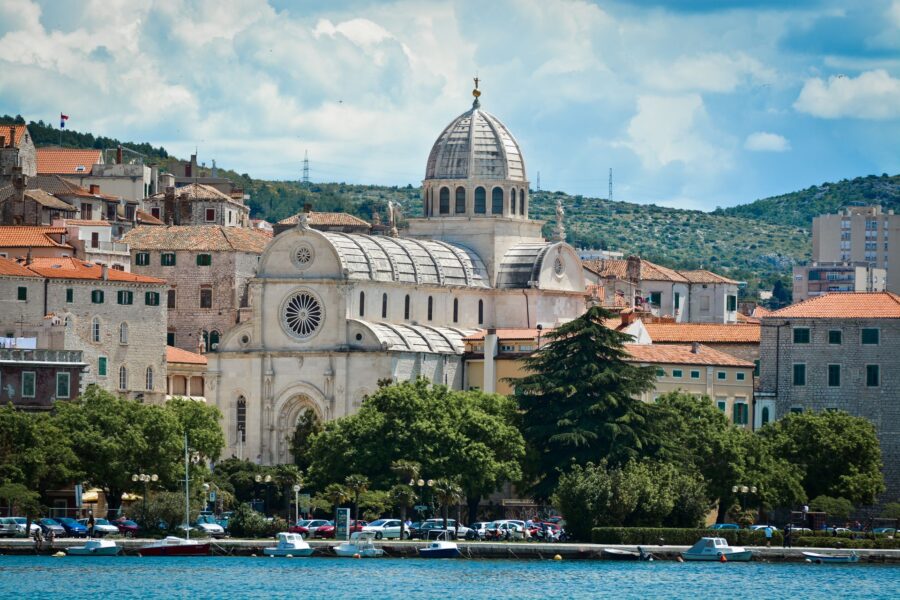
Šibenik holds a special place in Croatian history as the oldest native Croatian city on the Adriatic coast. Croatian kings founded the city in the 11th century.
The city’s most famous landmark, St. James Cathedral, was built between 1431 and 1555. This UNESCO World Heritage site shows off Šibenik’s wealth during the Venetian period.
The city defended itself through four fortresses built between the 15th and 17th centuries. St. Anthony’s Channel provided natural protection, while the fortresses guarded against Ottoman attacks.
Several ruling powers influenced Šibenik, from Croatian kings to Venetian rulers. Each left their mark on the city’s architecture and culture, creating a unique blend of styles and traditions.
Cultural and Modern Life
Split and Sibenik each bring unique flavors to Croatia’s cultural scene. Split pulses with year-round events in ancient venues, while Sibenik charms visitors with intimate festivals against medieval backdrops.
Cultural Festivities in Split
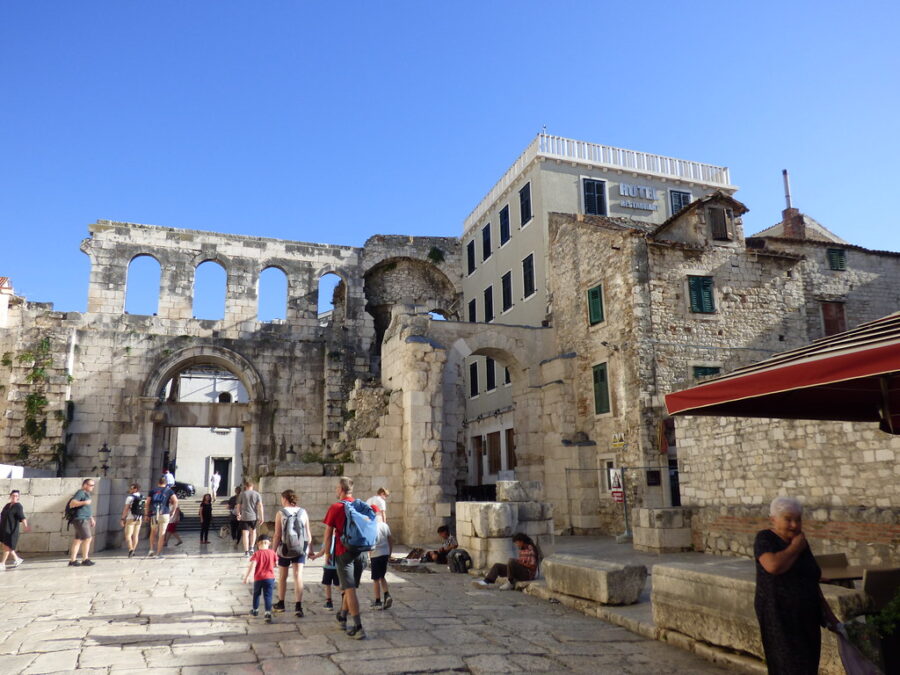
The ancient walls of Diocletian’s Palace come alive during Split Summer Festival, mixing modern performances with 1,700-year-old Roman architecture. Local bands play in the palace’s courtyards from June through September.
The Ultra Europe Music Festival draws thousands of electronic music fans each July. DJs perform at Poljud Stadium, creating an amazing mix of modern beats and Mediterranean vibes.
Split’s theater scene thrives at the Croatian National Theater, a yellow neo-baroque building from 1893. They stage Croatian plays and international works throughout the year.
Cultural Festivities in Sibenik
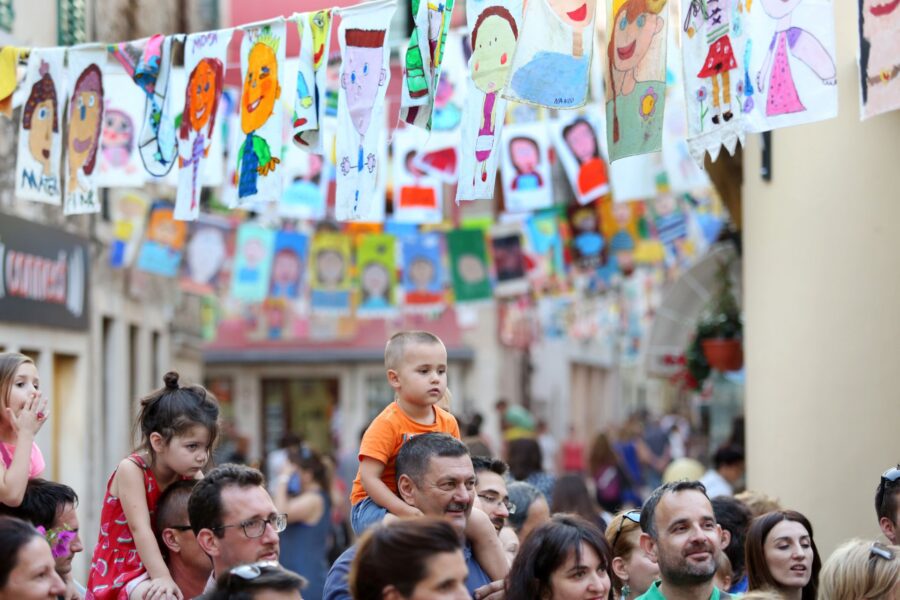
The International Children’s Festival transforms Sibenik’s streets each June. Kids perform music, dance, and theater shows in the medieval squares and along the waterfront.
St. James Cathedral hosts classical concerts where music echoes off its famous stone dome. These intimate performances happen weekly during summer months.
The Medieval Fair in September lets visitors step back in time. Local people dress in period costumes, serve traditional food, and demonstrate old crafts in the narrow stone streets.
Sibenik’s Evening of Dalmatian Songs celebrates local klapa singing. These traditional a cappella groups perform in the city’s squares on warm summer nights.
Tourism and Attractions
Split and Sibenik offer unique attractions that showcase Croatia’s rich history and culture through ancient buildings, stunning fortresses, and beautiful waterfronts.
Top Attractions in Split
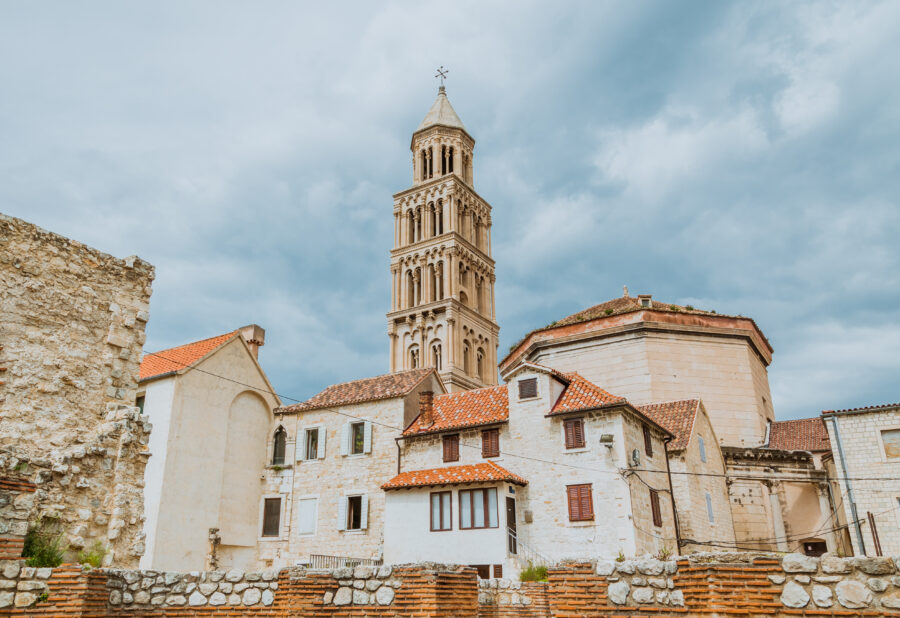
The iconic Diocletian’s Palace stands as Split’s crown jewel. This massive Roman complex takes up most of the city center, with narrow streets filled with shops, restaurants, and homes.
The Cathedral of Saint Domnius rises from the heart of the palace, featuring a striking bell tower that visitors can climb for amazing city views. The climb is worth every step!
The bustling Riva promenade stretches along Split’s waterfront. Palm trees line this popular spot where tourists and locals gather to watch stunning sunsets.
Marjan Hill provides a peaceful escape from the busy streets. The forested park offers walking trails, lookout points, and hidden beaches perfect for swimming.
Top Attractions in Sibenik
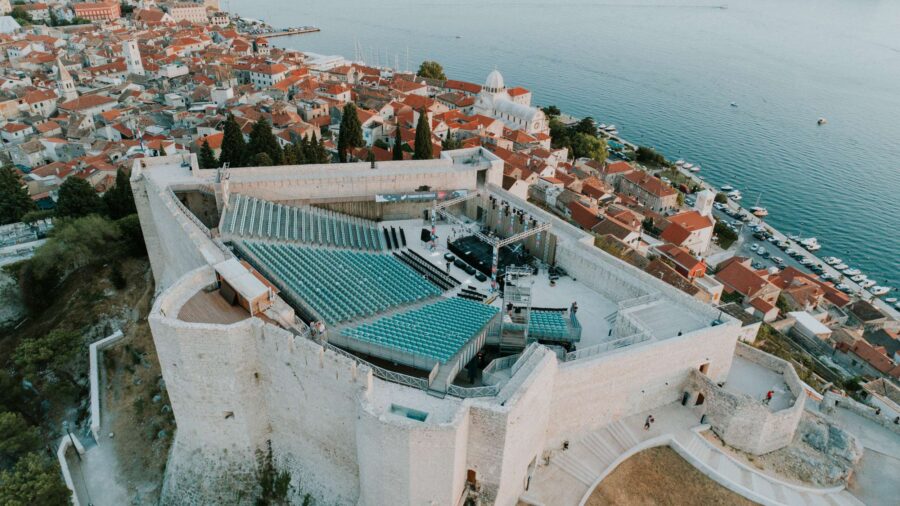
The stunning St. James Cathedral dominates Sibenik’s skyline. This UNESCO World Heritage site showcases unique stone carvings and architectural details you won’t find anywhere else in Europe.
St. Michael’s Fortress sits high above the city. The recently renovated fortress hosts summer concerts and gives visitors amazing views of the Sibenik archipelago.
The Medieval Mediterranean Garden offers a peaceful spot to relax. This small but beautiful garden recreates traditional monastery gardens with herbs and medicinal plants.
Barone Fortress tells the story of Sibenik’s defense against Ottoman attacks. Modern technology brings the fortress’s history to life through augmented reality displays.
Economic Comparison
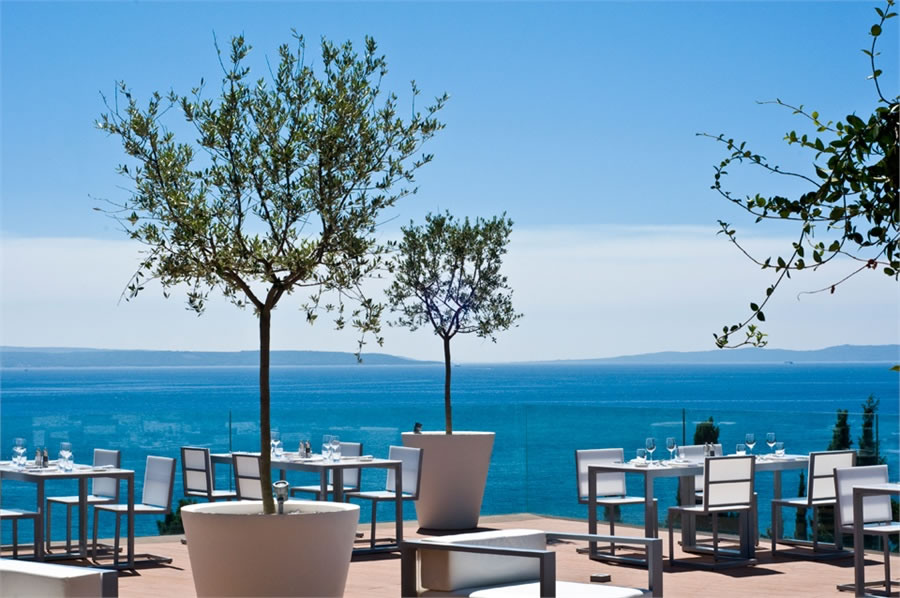
Split tends to be more expensive than Sibenik across most living costs. A person needs about €3,575 in Split to maintain the same lifestyle that would cost €3,000 in Sibenik.
Housing costs take up a big chunk of expenses in both cities. Rent prices in Split run higher than Sibenik, especially in the popular tourist areas near Diocletian’s Palace.
Food and dining show price differences too. Restaurants in Split charge more for meals, though local markets offer similar prices to Sibenik. Coffee shops and casual eateries in Sibenik give better value.
Daily expenses like groceries, utilities, and transportation cost less in Sibenik. The smaller city size means shorter travel distances and cheaper public transport fares.
Tourist activities hit the wallet harder in Split. Tours, museums, and entertainment venues charge premium rates during peak season. Sibenik offers similar experiences at more modest prices.
Money-saving tip: Visit local markets in both cities to get the best deals on fresh food and daily items. The green markets open early and close by afternoon.
Business opportunities differ between the cities. Split has a larger job market and more tourism-related work. Sibenik focuses on smaller industries and offers fewer but more stable employment options.
Analysis on Hajduk Split

Hajduk Split stands as one of Croatia’s most iconic football clubs, based in the stunning coastal city of Split. The team plays their home matches at the Poljud Stadium, which holds up to 34,000 passionate fans.
The club has shown mixed form in recent matches in the 1. HNL. Against Sibenik, they’ve dominated historically with 12 wins from 15 meetings, though their most recent clash ended in a surprising 0-1 defeat.
Key Statistics for 2024-25 Season:
- Home record: Strong
- Average attendance: 20,000+
- Main playing style: Attack-focused
- Top goal threat: Forward line
The team’s defensive line needs work, with several matches showing gaps in their backline organization. Their midfield creates many chances, but finishing has been inconsistent this season.
Their matches typically feature:
- High shot counts
- Aggressive pressing
- Strong possession stats
- Few yellow cards
The Split-based club maintains a fierce rivalry with Dinamo Zagreb. Local support remains incredibly strong, with fans known for creating an electric atmosphere at home games.
Recent performances suggest the team needs to improve their away form. Their home record shows much better results, with the Poljud fortress living up to its reputation.
Comparative Analysis

Split stands out as the larger and more bustling of these two Dalmatian cities. It offers more nightlife options, entertainment venues, and regular ferry connections to nearby islands.
Šibenik provides a quieter, more authentic Croatian experience. The city takes pride in its stunning UNESCO-listed Cathedral of St. James and offers easy access to Krka National Park.
The cities differ significantly in their tourist crowds. Split often gets packed with visitors, especially during peak season. Šibenik maintains a more relaxed atmosphere with fewer tourists.
Key Differences:
- Size: Split is larger with more amenities
- Atmosphere: Split = lively urban; Šibenik = laid-back local
- Activities: Split has more options for dining and entertainment
- Transportation: Split offers better ferry and bus connections
- Tourist Numbers: Split gets crowded; Šibenik stays calmer
For sports fans, Split has the famous Hajduk Split football club. Their home games at Poljud Stadium add extra excitement to the city’s atmosphere.
Most visitors spend 2-4 days in Split compared to 2-3 days in Šibenik. Split needs more time because it has more attractions and activities to explore.
The nightlife scene in Split is more diverse, with numerous bars, clubs, and live music venues. Šibenik offers a handful of cozy bars and occasional cultural events.
Frequently Asked Questions
Both Split and Sibenik offer unique experiences for travelers seeking to explore Croatia’s coastal regions. These cities feature rich histories, cultural landmarks, and distinct local atmospheres that appeal to different types of visitors.
What activities can travelers enjoy when visiting Sibenik?
Sibenik’s stunning Cathedral of St. James draws architecture lovers from around the world. The UNESCO World Heritage site shows off amazing stone carvings and Renaissance design.
Krka National Park sits just a short trip from town. Visitors can hike to waterfalls, swim in crystal-clear pools, and spot local wildlife.
The medieval fortresses of St. Michael, St. John, and Barone give amazing views of the Adriatic Sea. These restored sites tell stories of the city’s past.
How does the historical significance of Split compare to that of Sibenik?
Split’s ancient core centers on Diocletian’s Palace, a massive Roman complex that still buzzes with life. The limestone walls hold shops, homes, and restaurants.
The city served as a major Roman settlement and later became an important medieval trade hub. Many buildings show layers of history from different eras.
Sibenik grew as a Croatian royal city in medieval times. Its architecture reflects strong Venetian influences from centuries of rule.
Which destination between Split and Sibenik offers a more authentic Croatian experience?
Sibenik maintains a quieter, more traditional atmosphere with fewer tourist crowds. Local cafes and markets give visitors a taste of daily Croatian life.
Split mixes modern city energy with historic charm. While busier with tourists, many neighborhoods keep their local character.
The smaller size of Sibenik makes it easier to connect with residents and experience genuine Croatian customs.
What are the key differences in the cultural attractions of Sibenik and Split?
Split hosts more museums, galleries, and performance spaces. The Croatian National Theater puts on shows year-round.
Sibenik focuses on religious and military heritage sites. The fortress system tells the story of coastal defense through the ages.
Street festivals bring both cities alive in summer. Split tends to feature bigger events with international performers.
Can visitors discover unique culinary experiences in Sibenik, and how does it compare to Split?
Sibenik’s restaurants serve fresh seafood caught daily by local fishermen. Traditional Dalmatian cooking methods remain strong here.
Split offers more variety, from street food to fine dining. The famous fish market supplies both home cooks and restaurants.
Family-run konobas in both cities serve authentic dishes like pašticada and black risotto.
When choosing between a visit to Sibenik or Split, what advantages does each location offer?
Split works well as a travel hub with frequent ferries to islands and good bus connections. It also provides more accommodation choices.
Sibenik gives a peaceful base for exploring nature spots like Krka and Kornati National Parks. The smaller crowds in Sibenik mean more relaxed sightseeing.
Meanwhile, Split offers livelier nightlife and shopping options.


